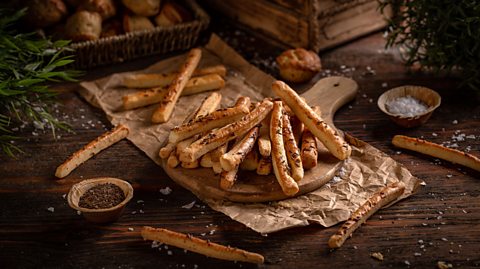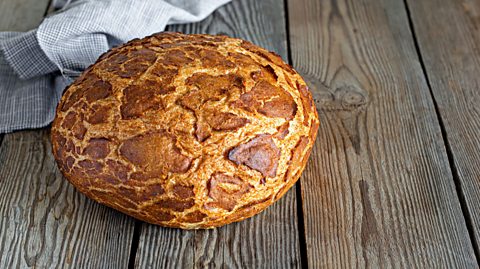Bread is one of the most ancient staples of human diet and culture, with the earliest evidence of breadmaking dating to about 14,000 years ago.
Naturally, this means there are thousands of varieties all over the world - and many have intriguing stories behind them. The yeast we could do is make a list; here are the origins of five fantastic breads.

Five tasty breads and their origins
1. Officially intangible: The baguette
Itâs hard to think of France and not think of French bread. And, in true French spirit, there are some pretty revolutionary stories around the baguette, including the belief that it was âthe bread of equalityâ which united the rich and the poor at the end of the French Revolution. Another common tale is that Napoleon Bonaparte requested the loaves be lengthened to make them easier to carry into battle, with baguette meaning âbatonâ.
These are most likely myths: the bread has been around since the 18th Century, but the lawful naming of the baguette as we know it today may have come a bit later in the 1920s. During this time baking hours were restricted by law to between 10pm and 4am, which meant a loaf with quick proving and baking times was needed before opening hours for bakeries. The lean dough is also defined by law - only flour, salt, water, Any substance that is used to make dough rise (typically yeast). and/or yeast - so what counts as a baguette is very official.
No matter the origin, this slice of history has earned the baguette the prestigious UNESCO Intangible Cultural Heritage (ICH) status, meaning itâs formally recognised as an important part of French culture.

2. Baked on demand: Breadsticks
Napoleon may not have taken baguettes into war, but itâs rumoured he was a big fan of breadsticks.
Breadsticks originated in 17th-Century Turin, a city in the province of Piemonte, Italy (at that time it was the Duchy of Savoy). Duke Vittorio Amadeo II of Savoy was a young member of the royal family with a lot of tummy problems. His father asked baker Antonio Brunero to make a bread which the young duke could digest easily. Antonio adapted ghersa - the local bread loaves - into thin strips which held less moisture and crisped upon baking - these were called grissini. The breadsticks were a smash hit, so much so that in the 19th Century, Napoleon had a stagecoach service set up exclusively between Turin and Paris to bring him âla petits batons de Turinâ (little sticks of Turin). Can't say we blame him.


3. Knot easy to twist: Pretzels
Itâs thought that Italian monks had a hand in the invention of the pretzel way back in the 7th Century. During Lent, when dairy, meat and eggs were abstained from, bread was important as only water, flour and a bit of salt is needed to make a soft dough. Pretzels would have been a bit different back then in terms of texture, but knotted in the same way - the three holes supposedly represent the Holy Trinity. Monks would twist and bake during the night, a fact which proved lucky in 16th Century Vienna; one night Turkish Ottoman soldiers attempted to dig a tunnel under the city walls, but the monks making pretzels heard them and quickly alerted the city, saving many lives from the potential invasion. The Viennese monks were awarded a coat of arms by the Austrian emperor, which is why golden pretzels can be seen hanging above bakeries all over Europe.
The story behind the name however is up for debate: some say the term came from âbracellaeâ which means âlittle armsâ in Latin and refers to the crossed shape of the pretzel. The German word âbretzelâ is thought to be derived from this word (and the soft pretzel as we know it was perfected in southern Germany). The other story behind the name is that it comes from âpretiolaâ, Latin for âlittle rewardâ, as pretzels were given to children who finished their prayers.


4. All-round innovation: The bagel
You might think of New York when you think of bagels (along with salmon, cream cheese and chives), but this bread is stuffed with a European heritage. Itâs thought that German immigrants settling in Poland in the 14th Century brought with them the soft pretzel, which was becoming a readily-available bread outside of monasteries.
In the 13th Century, Jewish communities were prohibited from baking in Poland. According to The Bagel author Maria Balinska, the law was repealed in 1264 by a Polish Prince known as Boleslaw the Pious, and so Polish Jews had the opportunity to bake commercially. Ashkenazi communities in KrakĂłw may have perfected the bagel recipe by adding malt to soft dough and pan-boiling the bread before baking, transforming an existing bagel-like bread known as the obwarzanek (adapted from the pretzel). This was once considered artisanal as wheat was not cheap, but became available to everyone as time went on - bagels and obwarzanki are still sold as Polish street food today.
The bagel kept on rolling across the Atlantic and Polish Jewish immigrants took it to the US. There it evolved into the softer, sweeter New York style we know and love.

5. A cracking loaf: Tiger bread (or giraffe bread)
Tiger bread comes from the Dutch tijgerbrod or tijgerbol (tiger roll), and its origins can be traced back to the 17th Century. During the Dutch colonisation of what is now India, Sri Lanka, Indonesia, and Taiwan, things like rice flour were taken back to Europe and used in recipes. Making a bread with a flour paste crust wasnât new, but the combination of rice flour and water resulted in a pale, mottled coat which cracked before baking and became associated with the Netherlands. The crust got tangier with time with the addition of sesame oil, and turned into that distinguished crunch. This was sold in bakeries as âtiger breadâ since at least the 1970s.
But all these tigers had nothing on three-year-old Lily. In UK supermarket Sainsburyâs, the loaf has been marketed as âgiraffe breadâ since 2012, following Lilyâs letter to customer services. Lily asked why itâs called tiger bread when the pattern is more befitting of a giraffe and, after overwhelming feedback on social media, Sainsburyâs went through with the name change, stating it as âA brilliant ideaâ.
This article was published in January 2023

From flying frogs to the purrr-fect cuppa: Unusual research studies that will blow your mind
±«Óătv Bitesize takes a look at some curious Ig Nobel Prize winning research studies.

Good luck symbols from around the world
Why acorns, beetles and small wooden horses can be seen as emblems of fortune.

The science to help you win on Pancake Day
How chemistry, physics and maths can help you excel at Shrove Tuesday
